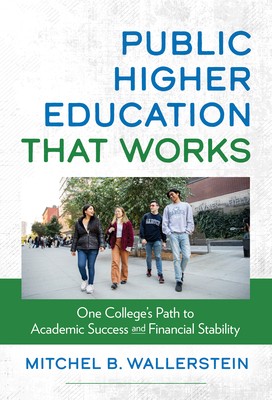
- We will send in 10–14 business days.
- Author: Mitchel B Wallerstein
- Publisher: Teachers College Press
- ISBN-10: 0807786446
- ISBN-13: 9780807786444
- Format: 15.8 x 22.6 x 0.8 cm, minkšti viršeliai
- Language: English
- SAVE -10% with code: EXTRA
Reviews
Description
Discover how one public higher education institution was able to succeed despite the many obstacles and challenges that it faced. This is the story of how and why Baruch College of The City University of New York became a "positive outlier," overcoming serious financial constraints, physical space limitations, and other difficulties to be highly ranked academically and financially stable. During a tumultuous time for public higher education, Baruch has graduated tens of thousands of smart and striving individuals (the majority of whom were the first in their family ever to attend college) with little or no educational debt. As the former president of the college, Mitchel Wallerstein analyzes the lessons learned, and he identifies the specific factors that explain Baruch's success. He addresses the question of whether there is anything unique about Baruch's approach--a "secret sauce," so to speak--that accounts for its academic success and financial strength, and he considers whether the Baruch model can be replicated by other public institutions.
Book Features:
- Reviews the history of public higher education, its development in the state of New York, and the important role it has played in the economic development of the United States.
- Presents a unique, comparative analysis of 15 public higher education institutions in 6 states across the country, comparing their strengths and standing in relation to one another and to Baruch College.
- Explores the replicability and sustainability of the "Baruch model" in the context of other public higher education institutions across the country.
- Reflects on the current and future challenges facing public higher education in the 21st century.
EXTRA 10 % discount with code: EXTRA
The promotion ends in 21d.10:52:30
The discount code is valid when purchasing from 10 €. Discounts do not stack.
- Author: Mitchel B Wallerstein
- Publisher: Teachers College Press
- ISBN-10: 0807786446
- ISBN-13: 9780807786444
- Format: 15.8 x 22.6 x 0.8 cm, minkšti viršeliai
- Language: English English
Discover how one public higher education institution was able to succeed despite the many obstacles and challenges that it faced. This is the story of how and why Baruch College of The City University of New York became a "positive outlier," overcoming serious financial constraints, physical space limitations, and other difficulties to be highly ranked academically and financially stable. During a tumultuous time for public higher education, Baruch has graduated tens of thousands of smart and striving individuals (the majority of whom were the first in their family ever to attend college) with little or no educational debt. As the former president of the college, Mitchel Wallerstein analyzes the lessons learned, and he identifies the specific factors that explain Baruch's success. He addresses the question of whether there is anything unique about Baruch's approach--a "secret sauce," so to speak--that accounts for its academic success and financial strength, and he considers whether the Baruch model can be replicated by other public institutions.
Book Features:
- Reviews the history of public higher education, its development in the state of New York, and the important role it has played in the economic development of the United States.
- Presents a unique, comparative analysis of 15 public higher education institutions in 6 states across the country, comparing their strengths and standing in relation to one another and to Baruch College.
- Explores the replicability and sustainability of the "Baruch model" in the context of other public higher education institutions across the country.
- Reflects on the current and future challenges facing public higher education in the 21st century.


Reviews